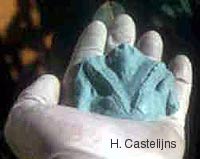Beyond the heart-bar shoe: current frog and sole support techniques
The heart-bar-shoe through its contact with the frog engages it in weight hearing. This function, which is natural for the frog of a bare foot, is important in the treatment of several pathologies of the foot, for example crushed and underrun heels, quarter cracks, and laminitis but also in the prevention of rotation and or sinking of the coffin bone in the case of extensive onicomicosis (seedy toe - white line disease) or hoof wall resections (eg. In the case of keratomas).
|
|
|
Fig.1 + Fig. 2
Heart bar positioning in laminitis therapy. |
|
Although the heart-bar-shoe has proved its therapeutic value in the past, it is not a shoe without practical disadvantages:
- Technical difficulty in making, shaping and fitting it correctly.
- A tendency for the frog to atrophy - or wear relatively quickly thereby diminishing its weight bearing function.
- Not very efficient when applied to certain narrow feet with small deeply set frogs.
- Can't (or should not) be used on horses sensitive to frog pressure or in the case of thrush.
- Of the palmar / plantar hoof structures only the frog is recruited into weigh bearing.
In the therapy of the pathologies mentioned before there are newer materials and techniques which can be used in combination or instead of the heart -bar and which offer simpler more efficient means of palmar / plantar hoof support.
|
|
|
|
Figure 3-4-5
Combined used of heart-bar-shoes and oral impression material. |
|
Specifically the use of fast setting silicones and polyurethanes kept in place by full or cut out pads or by thin steel or aluminium plates welded to the shoe or by the shoe design itself offer several advantages:
- Ease of use.
- The maleability before full hardening takes place permits to calibrate the amount of pressure desired.
- The whole frog instead of just par of it can be recruited in weight bearing as well as the bars and the whole or part of the sole.
- Ever widening choice of materials which permit to chose the hardnes required for each individual case (and in some cases even the weight)
|
|
Figure 6
The imprint shows the areas of the hoof participating in weigh bearing. |
|
Figure 7
Normal shoe with welded, pierced, sheet metal plate holding the impression material in place. |
|
Figure 8
Non traumatic shoeing for laminitis patients: glue on Dallmer cuff type shoe with screwed on (and removable) full rolling motion shoe holding palmar support of impression material in place |
|








